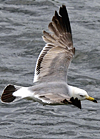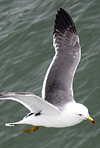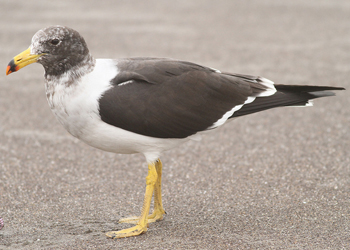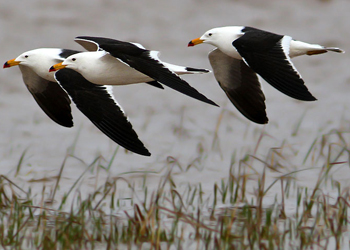 Black-tailed Gull (crassirostris) / ウミネコ / 괭이갈매기
Black-tailed Gull (crassirostris) / ウミネコ / 괭이갈매기
(last update: December 2015)
Black-tailed Gull (crassirostris) sub-adult April-June
Birds in 3rd cycle plumage or birds which are difficult to age exactly but show at least some features that indicate immaturity. Ageing can be difficult and birds are therefore grouped as "sub-adults".
GULLS OF THE AMERICAS - The Peterson Reference Guides
- Steve N.G. Howell / Jon Dunn -
Below is a copy of chapter 21 about Black-tailed Gull, illustrated with images from this website. "we" in the text below refers to the original authors. If any errors occur in this text, please let me know and mail to marsmuusseatgmaildotcom.
BACK TO PART 1 - INTRO AND FIELD IDENTIFICATION
BELOW: PART 2 - RARER SPECIES
RARER SPECIES
Adult Cycle. Belcher’s Gull and Olrog’s Gull (S. America) were formerly considered conspecific under the name Band-tailed Gull; they share a broad black subterminal tail band, yellow legs, and yellow bill with black-and-red tip. But otherwise they look quite different from Black-tailed Gull, being markedly larger and bulkier with longer legs and stouter bills, slaty blackish upperparts (Kodak 14-17), dark eyes, and often brighter yellow legs and bills; basic (and immature) plumages have dark mottled hoods.
HABITAT AND BEHAVIOR
Much as other medium-sized gulls, with which it is likely to be found (several N. American records have been with Mew, Ring-billed, and California Gulls); scavenges readily at dumps and fishing harbors.
DESCRIPTION AND MOLT
Adult Cycle. Complete PB molt (June/July-Oct./Nov.) produces adult basic plumage: head, neck, and underparts white; head and neck with variable (usually moderate) dusky clouding and mottling, often concentrated on hindneck. Back and upperwings slaty gray (Kodak 8-9.5) with black wingtips (black on outer web of P6/P7-P10 extends to primary coverts; P4 typically has black on outer web); white scapular and tertial crescents; and small white tips to outer primaries. White trailing edge to secondaries (usually hidden at rest) and inner primaries breaks into discrete white tips on outer primaries. Uppertail coverts and tail white with broad, clean-cut subterminal black tail band that does not extend to outer web of R6; closed tail from below shows limited black due to long white undertail coverts and white outer web to R6. Underwings show blackish wingtips merging into smoky gray, white-tipped inner primaries and secondaries.
Eyes pale lemon, orbital ring red (can be gray to pinkish in winter). Bill yellow to greenish yellow with broad black subterminal band adjoining orange-red gonydeal spot and tip. Legs yellow to greenish yellow. Partial PA molt (Sept./Oct.-Mar./Apr.) produces adult alternate plumage: head and neck clean white; white primary tips often lost through wear. Orbital ring red, legs brighter yellow; bill bright yellow with larger red gonydeal spot, and reduced subterminal black mark.
First Cycle. Juvenile (late July-Nov): dark brown overall with scaly buff (bleaching to whitish( edgings to upperparts becoming white on vent and tail coverts, which have sparse dark bars and spots; forehead, lores, throat, and eye-crescents often bleach to whitish. Tertials blackish brown with whitish edging, and wingtips black. Flight feathers black to brownish black, tail and secondaries narrowly tipped whitish.
IN FLIGHT; dark brownish overall with blackish flight feathers and contrasting white tail coverts; underwings dark. Eyes dark, bill starts out mostly dark but becomes flesh pink with clean-cut black tip by fall; legs flesh to flesh pink.
PA1 molt (Sept-Apr.; often include upperwing coverts) produces first alternate plumage: face and chest bleach to whitish, often offsetting a dusky hood and hindneck shawl (suggesting adult-basic pattern), white eye-crescents often less contrasting by spring, and some grayish feathers attained on head and body. Al scapulars and wing coverts variable, ranging from dark brown with pale edging, to brownish gray with dark anchor patterns, to fairly plain grayish. Eyes brown, bill flesh pink with clean-cut black tip, sometimes showing a yellowish cast and pale reddish tip by spring; legs flesh pink.
Second Cycle. Complete PB2 molt (late May/June-late Aug./Sept.) into second basic plumage. Head, neck, and underparts whitish with variable dusky brown clouding and mottling heaviest on hindneck and across chest; forehead, lores, throat, and eye-crescents whitish; vent and tail coverts white with no to few dark marks. Upperparts mixed dusky brown and gray, some feathers with contrasting pale edgings. Flight feathers blackish with narrow whitish tips to secondaries, inner primaries, and tail; white basal corners to outer rectrices visible on spread tail. Wing-linings whitish with variable dusky clouding. Eyes brown to pale lemon, bill flesh pink to gray-green with black distal third and usually a reddish tip, legs flesh pink to gray-green. Partial PA2 molt (Sept.-Apr.; often includes upperwing coverts) produces second alternate plumage: head, neck, and underparts white, variably streaked and mottled dusky (often bleaching and wearing to mostly white by summer), back becomes mostly plain gray, and many birds attain some gray upperwing coverts, especially median coverts. By spring and summer, orbital ring may show reddish; bill greenish to yellow with broad black subterminal band, red tip, and often a trace of orange-red gonydeal blush. Legs flesh to gray-green, sometimes becoming yellow-green in summer.
Third Cycle. Complete PB3 molt (late May/June-Sept./Oct.) produces third basic plumage: overall resembles adult basic but averages more dusky streaking and mottling on head and neck; white tips to wingtips smaller or absent; some upperwing coverts often washed brownish; tertials can have brown centers. Wingtip pattern averages more extensively black than adult, with variable blackish on primary coverts and alula, sometimes black on P3. Underwings may have slight dusky clouding on coverts. Bare parts similar to adult but bill and legs average more greenish yellow through winter. Partial PA3 molt (Sept./Oct.-Mar./Apr.) into third alternate plumage: head and neck clean white, white tips to outer primaries can be lost by wear; best aged by wingtip pattern. Bill and legs brighten in late winter, often indistinguishable from adult by summer. Adult plumage attained by complete PB4 molt (June-Sept./Oct.).
HYBRIDS
None reported.
NOTES
1. Dwight 1925; 2. Anon 2003; 3. Heinl 1997; 4. Lethaby and Bangma 1998; 5. Wahl et al. 2005; 6. Garrett and Molina 1998; 7. ABA 2002; 8. Anon 2003; 9. Lethaby and Bangma 1998
 Black-tailed Gull (crassirostris) sub-adult, May 16 2009, Matsushimakaigan, Japan. Picture: Tsukacyi.
Black-tailed Gull (crassirostris) sub-adult, May 16 2009, Matsushimakaigan, Japan. Picture: Tsukacyi. Black-tailed Gull (crassirostris) 3rd cycle (4CY), June 26 2015, Seoul, South Korea. Picture: Emes Kei.
Black-tailed Gull (crassirostris) 3rd cycle (4CY), June 26 2015, Seoul, South Korea. Picture: Emes Kei. Black-tailed Gull (crassirostris) sub-adult, May 16 2009, Matsushimakaigan, Japan. Picture: Tsukacyi.
Black-tailed Gull (crassirostris) sub-adult, May 16 2009, Matsushimakaigan, Japan. Picture: Tsukacyi. Black-tailed Gull (crassirostris) sub-adult, June 22 2014, Hachinohe-shi, Aomori Prefecture, Japan. Picture: Dyeworks.
Black-tailed Gull (crassirostris) sub-adult, June 22 2014, Hachinohe-shi, Aomori Prefecture, Japan. Picture: Dyeworks.
